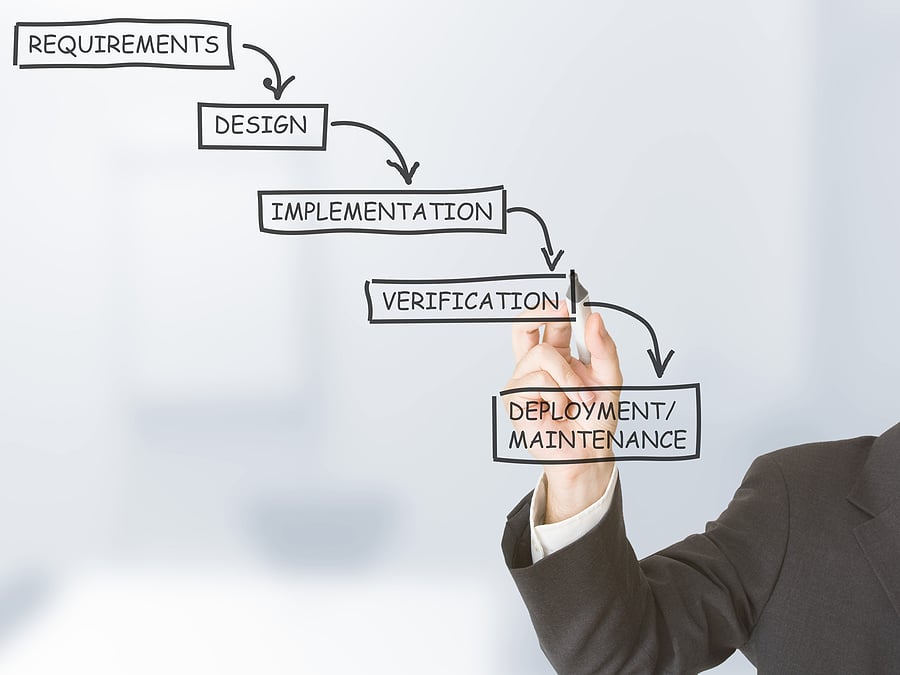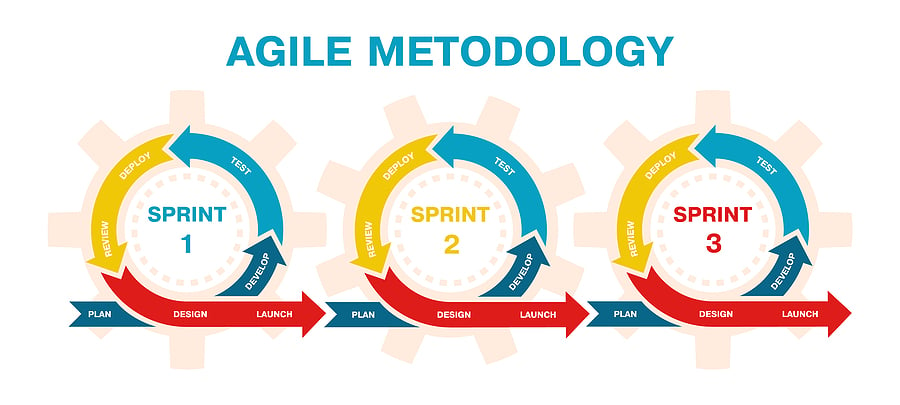Software development process - Your guide for a successful project
8 min read
Topic:
ASP.NET Development Services
There are many different process models and frameworks for managing the software development life cycle (SDLC), but all of them share some common stages: planning and software requirements gathering, software design, implementation, testing, deployment, and maintenance. This is the foundation of industry-standard software engineering.
Choosing the right software product development process for your project is essential—it will control how the project flows, how rapidly code is deployed, and how quickly it is completed.
Let's take a deeper look at the software development life cycle models, from start to finish.
Popular Software Development Methodologies
There are many different software development methodologies, each with its own advantages and disadvantages. Software development methodologies began with the "Waterfall" methodology decades ago and then transitioned to "Agile and Scrum." From there, it's evolved into incremental and iterative models such as DevOps.
Waterfall
The waterfall model is the traditional approach to business software development in which you complete each stage of the process before moving on to the next.
This means that all the requirements must be gathered and understood before any software design or coding can begin. It also means that it is difficult to modify the project once it has begun; these requirements will remain static throughout.
The main advantage of the waterfall strategy is that it is easy to understand and manage since each stage has a well-defined beginning and end. Waterfall methodologies can protect code quality and avoid scope creep.
The main disadvantage is that it can be inflexible since you cannot go back to a previous stage without starting the process over from the beginning.
Most companies no longer use waterfall methodologies or they have sufficiently evolved their strategies so they no longer follow the typical waterfall flow. Waterfall tends to be too slow in the currently fast-paced world of software product development.

Agile and Scrum
The agile methodology is a more modern approach that emphasizes iterative development and collaboration between stakeholders. In the agile model, requirements and design are not completed all at once—rather, they are completed in small pieces, or "sprints."
This means that stakeholders can see and use the product much sooner than in waterfall. It also means that the project can be changed or modified more easily as feedback is gathered throughout the development process.
The main advantage of the agile model is that it is more flexible and can adapt to changes more easily and is best suited for rapid application development.
The main disadvantage is that it can be more difficult to manage since there are more moving parts.
Scrum is a popular framework for implementing agile development. It includes roles such as "Scrum Master" and "Product Owner," as well as specific ceremonies such as sprint planning and the daily stand-up. Scrum breaks projects down into small increments, or sprints, and uses a cross-functional team to complete them.
The main reason Elon Musk’s SpaceX can develop a complex rocket system in a fraction of the time as a government entity is that it relies heavily on agile development whereas governmental agencies tend to use a waterfall methodology. This is in part because government budgets need to be approved years in advance. Agile development allows Musk to “fail faster” meaning that SpaceX can learn from mistakes sooner, pivot, and go in a completely different direction if need be. This is very difficult and costly to do under the constraints of a waterfall methodology.

Incremental and Iterative
The incremental methodology breaks the project down into smaller parts, and each part is developed and deployed separately. The iterative methodology is similar to the incremental methodology, but each part of the project is developed and tested multiple times before being deployed. An example of incremental and iterative methodologies is DevOps.
DevOps is a methodology that emphasizes communication and collaboration between developers and operations teams. It helps to automate the incremental development process, so that code can be quickly and efficiently deployed.
The main advantage of DevOps is that it speeds up the software development process by automating many of the tasks.
The main disadvantage is that it can be difficult to implement since it requires a lot of coordination between different teams.
Choosing the right agile software development methodology for your project depends on many factors, such as the size and complexity of the project, and the project's ultimate goals. Today, most software development is conducted in either a mix of agile or DevOps. Studies have shown that an iterative approach leads to better software quality and lower costs.
The 6 Software Development Process Steps
What are the standard steps of the web application development process?
The answer to this question can vary depending on who you ask, but there are generally six accepted steps. Understanding what occurs at each of these steps will help you keep your custom software development process meeting its milestones and deadlines.
Let's take a closer look at each step of the development process.
1 - Analysis and Requirements
The first stage of any project is analysis, requirements gathering, and writing a software specification, a roadmap if you will. You need to understand the goals and objectives of the project and gather the requirements from stakeholders. This will help you determine what kind of solution you need to design to meet the company’s business needs.
During this requirements analysis stage, you will also create a software project plan. These design documents will include the project timeline, milestones, risk assessment, and deliverables. Challenges related to analysis and requirements include scope creep and unclear objectives.
2 - Design and Prototype
The next stage is design and prototype. In this stage, you create diagrams and flowcharts to specify the functionality and behavior of the software. You can also create a prototype of the software to test its feasibility. This gives the stakeholders something tangible to look at and comment on which fosters better communication as to what is really needed.
The goal of this phase is to get sign-off from stakeholders on the overall design and specification. Challenges related to designing and prototyping include unrealistic deadlines and changes to requirements. Once the design is complete and the teams know what is to be built, cost estimation can finally be done. More often than not, clients demand cost estimation based on incomplete information. This leads to cost overruns.

3 - Software Development
The third stage is custom software development phase. This is where you actually write the code for the web application in a development environment like ASP.NET & SQL Server and employ a popular programming language like C#. You need to consider the design and prototype when writing the code so that the final product meets the requirements.
The goal of this phase is to create working software that can be tested. Challenges related to software product development include errors in the code and unexpected behavior.
4 - Software Testing and Refinement
After the code has been written, it needs to be run through a quality assurance process to check if it meets the requirements. This validation is done by running test cases and comparing the results with the expected results. If there are any discrepancies, you need to fix them before proceeding. Today, a lot of testing can be performed through automation.
The goal of this phase is to make sure that the software is free of bugs and errors. Challenges related to testing and refinement include unforeseen issues and test cases that are too narrowly focused. The programmer first does unit testing. Then the software may be tested against narrow audience sets—such as staff members who already understand the platform. Ample testing is critical if the goal is to produce high-quality software.
5 - Deployment
The next stage is deployment. You need to install the software on a server or computer and make it available to users. Deployment is one of the most delicate stages, as it's when the system could potentially break or disrupt the organization's operations.
The goal of this stage is to make the software available to users with minimal disruption. Challenges related to deployment include data loss, business disruption, and training of staff to use the new system.

6 - Maintenance
Finally, you need to provide support and maintenance for the software after it has been deployed. This includes fixing any bugs that might be found and adding new features or functionality as required. Maintenance is an ongoing process, and it needs to be budgeted for accordingly.
The goal of this stage is to keep the software functioning as intended. Challenges related to maintenance include unexpected behavior and hardware failures.
As you can see, there are six distinct steps in the software development cycle. Understanding what occurs at each step will help you keep your software development project on track and ensure that it meets its deadlines.
However, consider that the software development process changes somewhat when you introduce living software systems such as SaaS (Software as a Service). SaaS systems are never fully "complete" and may never enter a true maintenance phase. Rather, changes will continually be launched throughout the development cycle. Saas systems depend on continuous improvement and continuous integration to constantly add new modules and functionality to the existing system.
As a result, the software development cycle for SaaS systems is more iterative in nature. It never fully completes but rather it cycles between all of the above software processes over and over.
The skill sets needed for the software development team
Today, the emphasis is on cross-functional agile software development teams that work well together and provide unique specializations. Let's take a look, first, at the skills that the entire team needs to have.
- First, the development team must be able to communicate effectively. This includes being able to understand the requirements of the project and being able to communicate their own ideas clearly.
- Secondly, the software team must be able to work together efficiently. This means being able to share ideas and come to a consensus on the best course of action in the form of a requirement specification.
- Thirdly, the project team must be able to work with other teams in the organization. This includes being able to coordinate efforts and being able to understand the workflow needs of other departments.
- Fourth, the team must be able to handle changes. This means being able to adapt to new requirements or changes in the organization. They have to remain agile while still avoiding scope creep.
- Finally, a high-performance project team must be able to deliver on their commitments. This includes being able to meet deadlines and being able to produce quality work. If commitments change and they are not able to deliver what they are intended to deliver, they must communicate effectively.

These are just a few of the skills that are needed for the agile software development outsourcing team as a whole. But there are individual skill sets required for each role, too.
- Business Analyst. A business analyst is responsible for understanding the needs of the business and translating those needs into business requirements for the software. They need to be able to understand the business process and identify areas where the software can be improved.
- Software Architect. A software architect is responsible for designing the overall software architecture of the web application. They need to be able to understand the user requirements and design a solution that meets those requirements. They also need to be aware of the latest trends in software development and be able to incorporate those into the design.
- Database Architect. A database architect is responsible for designing the database that will be used by the software. They need to be able to understand the data requirements and design a database that meets those requirements. They also need to be able to optimize the performance of the database and ensure that it is scalable.
- Front-End Developer. A front-end developer is responsible for developing the user interface and user experience for the software. They need to be able to understand the UX requirements and design a user interface that meets those requirements. They also need to be able to develop the code that will make the user interface work.
- Back-End Developer. A back-end developer is responsible for developing the code that will power the software. They need to be able to understand the analysis requirements and design a solution that meets those requirements. They also need to be able to optimize the performance of the code and ensure that it is scalable.
- Software Tester. A tester is responsible for testing the software to ensure that it meets the requirements. They need to be able to understand the customer use cases and the customer requirements and design a test plan that makes sense for these scenarios. They also need to be able to execute the test plan and report any issues that are found.
- Project Manager. A project manager is responsible for ensuring that the project is completed on time and within budget. They need to be able to understand the stakeholder's requirements and create a project plan that meets those requirements. They also need to be able to track the progress of the project and make sure that all stakeholders are kept up to date.
Together, all these individuals will be essential to the software development life cycle. If they work smoothly together, the software development project will be a success.
Summary
In order to be successful, a software application development company needs to follow a thorough software development model and implement strict controls. Further, a software development company needs to have a robust skillset—the skillset necessary to fulfill their roles.
Business analysts, software architects, database architects, front-end developers, back-end developers, software testers, and project managers all play an important role in web application development. Likewise, though, the very infrastructure of the software development life cycle will play a part.
Today's software companies frequently use agile or DevOps methodologies to empower cross-functional teams to achieve their goals. Choosing the right agile software development team is critical to automating business processes that will give you a competitive edge.
To find out more information about our ASP.NET software development outsourcing capabilities, or if you’d like to discuss your ASP.NET needs with Keene Systems CEO, Lance Keene click here to book a call with him. You can also download our great new eBook - Why ASP.NET Development Services Fuels Business Growth - to learn more about this essential topic.


